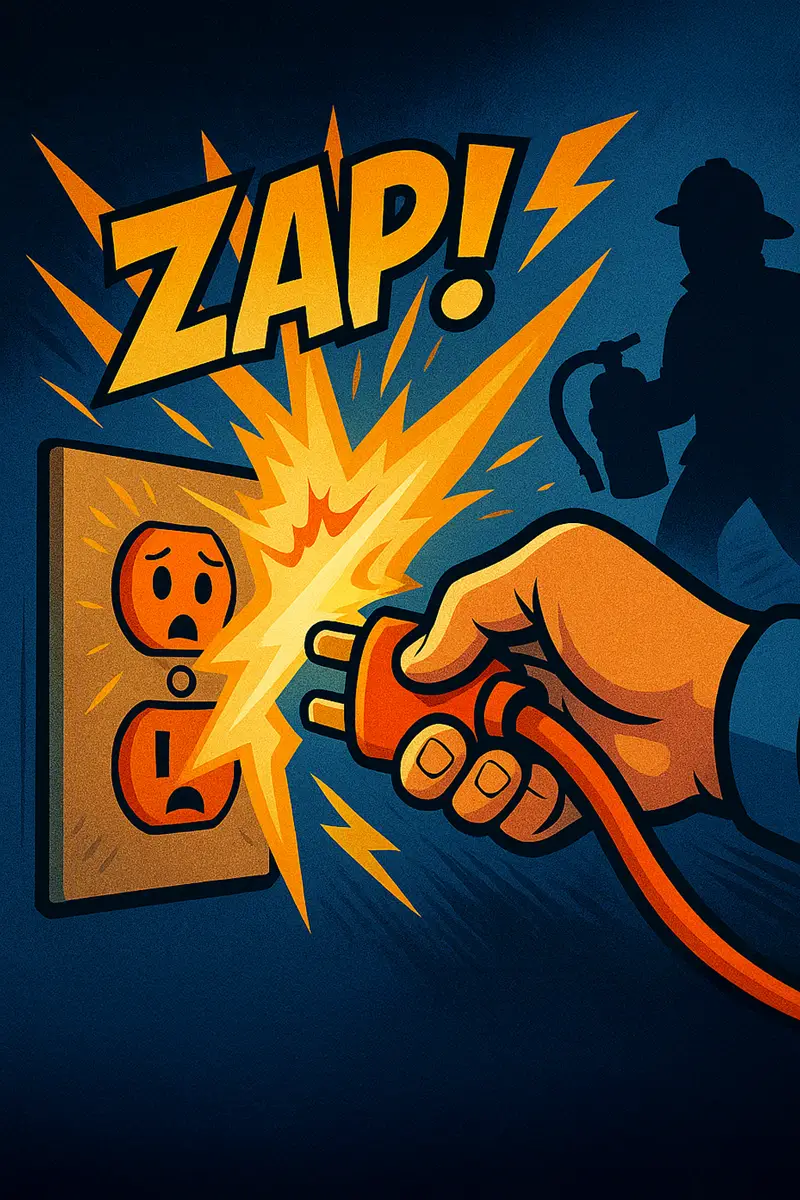
A sparking outlet or switch is when you see a visible spark jump either when you plug something in or turn a switch on/off. It can range from a tiny blue zap that you catch out of the corner of your eye, to a bigger, crackling spark that might leave scorch marks. Usually, homeowners notice this as a brief flash when inserting or removing a plug from an outlet. With switches, you might see a spark if you remove the cover plate and operate it (or if the switch is seriously faulty, a spark could even flicker out from behind the plate). Accompanying symptoms can include a popping sound, a burning smell, or that the outlet/switch stops working properly after the spark.
In the daily battle against electrical gremlins, sparking outlets make frequent appearances in DMV area homes. One reason is simply wear and tear – many homes around DC and Northern Virginia have outlets and switches decades old. Over time, the internal metal contacts can loosen or corrode. So when you plug in a device, the connection might not be solid, causing electricity to literally “jump the gap” – hence the spark. Additionally, the region’s older homes might have had many hands of DIY wiring over the years. We often come across outlets with loose screws or backstabbed connections that were never super tight to begin with. Combine that with plugging and unplugging appliances regularly, and sparks can fly. Another factor: surges or high draw appliances. Plugging in a vacuum cleaner or space heater (which draw a lot of current) can sometimes cause a brief spark even in a healthy outlet – that’s somewhat normal called “load spark.” But if it’s frequent or large, that’s not normal. Also, humidity can play a role; although less common, moisture in an outdoor outlet or even high indoor humidity can contribute to arcing when connecting. In summary, the mix of aging infrastructure, heavy device usage, and occasional DIY mishaps in our area makes sparking outlets an issue we get called about quite often.
While that little spark might seem minor, it’s actually a mini lightning bolt and should be treated with respect. Frequent sparks are a sign of a problem – either in the outlet, the switch, or the way it’s wired. The biggest concern is that sparking means arcing – electricity is leaping through the air. Arcing generates a lot of heat, and it can carbonize the surrounding material. This can lead to electrical fires, especially if the spark ignites insulation or dust inside the wall. Even if it doesn’t flame up immediately, each spark can deteriorate the metal contacts further (creating more resistance and heat in a vicious cycle). Also, a strong spark could potentially deliver a shock to the person plugging in, especially if it’s a result of a short circuit and you’re holding the plug. If you’ve ever seen an outlet that’s visibly charred or a switch that gave a shock, that’s the aftermath of uncontrolled sparking. Beyond immediate dangers, a sparking outlet can fry the device you’re plugging in – the voltage spike isn’t friendly to sensitive electronics. Essentially, consistent sparking is both a fire hazard and an electrocution hazard, making it a double no-no.
If an outlet or switch sparks once in a tiny way, you might chalk it up to static or a normal small arc from a heavy appliance. But use your judgment: if it’s happening repeatedly, or the spark was large, bright, accompanied by noise, or left a mark, you should stop using that fixture and call an electrician. Also, if any outlet or switch continues to buzz or sizzle after a spark, immediately turn off the circuit at the breaker and get a pro to inspect it – that’s a sign of an ongoing arc. A licensed electrician will do a few things: cut power and open up the outlet or switch to inspect for visible damage or loose wiring. Often, we find the cause quickly – a loose hot wire, a broken outlet where contacts don’t hold the plug snugly, or evidence of arcing (burn marks) that mean the device has failed. The fix might involve replacing the outlet or switch with a new, high-quality one (a relatively quick fix) and tightening/redoing the connections with proper technique. If the wiring is damaged, they’ll cut back and re-strip the insulation to work with clean wire. Importantly, an electrician will also consider if the sparking outlet is a symptom of a bigger issue – like a circuit that’s not properly grounded, or overloaded circuits causing wear. They might test the circuit on a whole for any other irregularities. And if by chance the spark came from inside a wall (like a junction box arcing), they have the tools to locate it and fix that hidden hazard. Remember, electricians are like arc-fighters – we train to find even small signs of arcing before they escalate. By calling one in, you’re preventing a potential fire and ensuring that outlet or switch doesn’t spark again when you least expect it.
Those little sparks might look like tiny fireworks, but they’re not worth celebrating. In comic terms, if electricity were a hero, sparking is when it misbehaves like a villain. Dr. Electric’s team comes armed with the “magic hammer” – metaphorically speaking – to banish that villain by tightening up connections or swapping out faulty parts. It’s a quick win that keeps your home safe. So don’t brush off sparks as normal; even superheroes know that a single spark can ignite a whole powder keg. Stay safe and let the pros zap the problem!
Dr. Electric offers a range of services to enhance safety, reliability, and performance. Get in touch or check out our List of Common Electrical Requests.
You can also text our support team at 833-337-3532 or email: info@drelectric.com